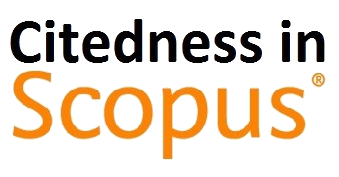Model of Data mining Clustering Rules on Population Determination of Trade and Accommodation Facilities in Indonesia with K-Means
(1) Informatics Study Program, Institut bisnis dan informatika Kosgoro 1957
(*) Corresponding Author
Abstract
The research aims to conduct a mapping model in the form of the grouping of residents of trade and accommodation facilities according to regions in Indonesia using data mining techniques. This research is a reference specifically for the role of the government in increasing regional income in Indonesia evenly. The data source is obtained from the government statistical data provider website, namely the Central Statistics Agency (BPS) with the URL address www.bps.go.id. The mapping method used is K-Mens and tested with the Rapid Miner software. There are 3 clusters used in mapping the area to the population of trade and accommodation facilities, namely the high (C1), medium (C2), and low (C3) clusters. The results obtained are cluster C1 centroid data, namely ((1527), (810.4), (5865), (6655.3), (323), (315.1)); cluster C2, namely ((286), (199,591), (1327), (2240,227), (93,227), (140,955)); and cluster C3, namely ((139,25), (122,5), (508,833), (919,222), (64,417), (94,444)). The results of the mapping show that in cluster C3, there are 16 provinces with a low population of trade and accommodation facilities.
Full Text:
PDFReferences
P. Alkhairi and A. P. Windarto, “Penerapan K-Means Cluster Pada Daerah Potensi Pertanian Karet Produktif di Sumatera Utara,” Semin. Nas. Teknol. Komput. Sains, pp. 762–767, 2019.
A. P. Windarto et al., “Analysis of the K-Means Algorithm on Clean Water Customers Based on the Province,” J. Phys. Conf. Ser., vol. 1255, no. 1, 2019, doi: 10.1088/1742-6596/1255/1/012001.
A. P. Windarto, “Penerapan Data Mining Pada Ekspor Buah-Buahan Menurut Negara Tujuan Menggunakan K-Means Clustering,” Techno.COM, vol. 16, no. 4, pp. 348–357, 2017.
A. P. Windarto, “Implementation of Data Mining on Rice Imports by Major Country of Origin Using Algorithm Using K-Means Clustering Method,” Int. J. Artif. Intell. Res., vol. 1, no. 2, pp. 26–33, 2017.
I. Kamila, U. Khairunnisa, and Mustakim, “Perbandingan Algoritma K-Means dan K-Medoids untuk Pengelompokan Data Transaksi Bongkar Muat di Provinsi Riau,” J. Ilm. Rekayasa dan Manaj. Sist. Inf., vol. 5, no. 1, pp. 119–125, 2019.
B. Wira, A. E. Budianto, and A. S. Wiguna, “Implementasi Metode K-Medoids Clustering Untuk Mengetahui Pola Pemilihan Program Studi Mahasiwa Baru Tahun 2018 Di Universitas Kanjuruhan Malang,” Rainstek, vol. 1, no. 3, pp. 54– 69, 2019.
S. Harikumar and P. V. Surya, “K-Medoid Clustering for Heterogeneous DataSets,” Procedia Comput. Sci., vol. 70, pp. 226–237, 2015, doi: 10.1016/j.procs.2015.10.077.
J. Jamal and D. Yanto, “Analisis RFM dan Algoritma K-Means untuk Clustering Loyalitas Customer,” Energy, vol. 9, no. 1, pp. 0–8, 2019.
P. Arora, Deepali, and S. Varshney, “Analysis of K-Means and K-Medoids Algorithm for Big Data,” Phys. Procedia, vol. 78, no. December 2015, pp. 507–512, 2016, doi: 10.1016/j.procs.2016.02.095.
DOI: https://doi.org/10.30645/ijistech.v4i1.86
Refbacks
- There are currently no refbacks.
Jumlah Kunjungan:
Published Papers Indexed/Abstracted By:












